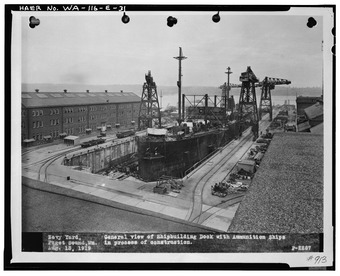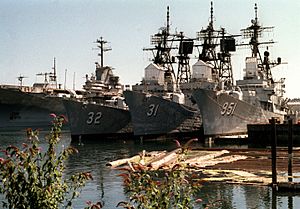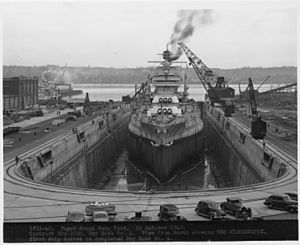Puget Sound Naval Shipyard Historic District facts for kids
Quick facts for kids |
|
|
Navy Yard Puget Sound
|
|

General view of Shipbuilding Dock with Ammunition Ships in process of construction. August 13, 1919.
|
|
| Lua error in Module:Location_map at line 420: attempt to index field 'wikibase' (a nil value). | |
| Location | N shore of Sinclair Inlet, Bremerton, Washington |
|---|---|
| Area | 189 acres (76 ha) |
| Architect | US Navy |
| NRHP reference No. | 92001883 |
| Added to NRHP | August 27, 1992 |
The Puget Sound Naval Shipyard is a huge military base in Bremerton, Washington. It sits along the north shore of Sinclair Inlet, which leads out to Puget Sound. This shipyard is about 2.4 kilometers long along the shore. It is also over 0.8 kilometers wide at its biggest point.
The shipyard has almost 1,000 buildings and structures. These include places where ships are built and fixed, repair shops, and huge drydocks. There are also piers, cranes, and railways. Besides the industrial areas, there are also homes for officers and sailors. You can find recreation spots, power stations, and medical facilities too. A small part of the shipyard, about 76 hectares, is a historic district. This shipyard was super important during World War II because it fixed many large warships. These ships were damaged in battles across the Pacific Ocean. In 1992, it was named a National Historic Landmark District.
Contents
How the Shipyard Began
As early as 1867, army engineers suggested building a naval station on the West Coast. They thought Puget Sound would be a good spot. In 1889, the Navy started looking for a navy yard in the Pacific Northwest. They picked a place called Point Turner, where Bremerton is now.
It took a few years to get approval and money because of disagreements. Finally, in 1891, the Navy bought 77 hectares of land. They paid $9,513 to a land seller named William Bremer. Construction started in 1892 with Drydock No. 1. This drydock was finished in April 1896. On April 11, 1897, the USS Oregon was the first ship to use the new station. In 1902, the station's name changed to Navy Yard Puget Sound. In 1908, the famous Great White Fleet returned to the U.S. after traveling around the world. They stopped at the Navy Yard Puget Sound to refuel.
Shipbuilding During World War I
Drydock 2 was finished in 1913. It was built using strong granite and concrete. At that time, it was the largest drydock in the U.S. Navy. In 1917, before the United States joined World War I, the Navy decided to build ships at the yard. Drydock 3 was built for this purpose, but it wasn't finished until 1919.
By the end of the war, about 6,500 workers in Bremerton had built 42 ships. These included subchasers, submarines, minesweepers, ocean tugs, and ammunition ships. They also built 1,700 smaller boats. Shipbuilding continued between the two World Wars. The light cruiser USS Louisville was launched in 1930. The cruiser USS Astoria followed in 1933. In the 1930s, Drydock 2 was made even bigger. This was to fit two new aircraft carriers, the USS Lexington and the USS Saratoga.
The Shipyard in World War II
From 1938 into the early 1940s, the Navy Yard Puget Sound got many big upgrades. They built two new drydocks, Drydock 4 and 5, which were 305 meters long. These were big enough for the new, fast battleships being built. New docks, piers, and shop buildings were also added.
Five battleships damaged at Pearl Harbor on December 7, 1941, came to Bremerton for repairs. These were the USS Tennessee, USS Maryland, USS Nevada, USS California, and USS West Virginia. The Tennessee got new powerful guns and modern anti-aircraft guns. The Nevada was rebuilt a lot and left Puget Sound for battle in 1943. The California had sunk at Pearl Harbor. It was lifted up and brought to Bremerton for repairs. The California rejoined the fight in January 1944. The West Virginia was hit by many torpedoes. It took longer to fix, rejoining the fleet in July 1944.
In January 1944, the Maryland and Colorado came to Puget Sound for rebuilding. Both battleships returned to the fleet in time for the attack on the Marianas. Other famous battleships that came to the yard during the war included the USS Pennsylvania, USS Washington, USS New Jersey, and USS South Dakota.
When the aircraft carrier Saratoga was hit by a Japanese submarine in January 1942, it was sent to Bremerton. It needed repairs and updates. The hope was to get it ready for the Battle of Midway in June, but the work was too much. Other carriers sent for repairs included the USS Enterprise, USS Bunker Hill, USS Franklin, USS Ticonderoga, USS Wasp, and Lexington.
Later in the war, when kamikaze attacks started, many ships needed quick repairs. The destroyer USS Lamson was hit by a kamikaze in December 1944. Many sailors were hurt or killed. The ship's upper part was destroyed, and a room filled with water. The Bremerton yard replaced 90% of the damaged upper part in just a few months. Because kamikaze attacks increased, fixing ships quickly became very important. By the end of the war, the Navy Yard Puget Sound had repaired, updated, and fixed 344 warships of all kinds. On August 12, 1944, President Franklin D. Roosevelt visited. From Drydock 2, he thanked the workers for their amazing help in the war.
After the War

On December 1, 1945, the navy yard's name changed to Puget Sound Naval Shipyard. After the war, a special area for inactive ships was added. Until 1998, the USS Missouri was kept here. For a while, people could even visit it.
Today, inactive ships at the shipyard include aircraft carriers, cruisers, destroyers, and submarines. The Puget Sound Naval Shipyard has been busy since World War II. During the Korean War, it helped get ships ready for action again. In 1957, they started building ships that could launch guided missiles. Since 1961, Puget Sound has been fixing both regular and nuclear-powered aircraft carriers, surface ships, and submarines.
Historic Areas of the Shipyard
The Puget Sound Naval Shipyard has five special historic areas:
- Officers' Row Historic District
- Puget Sound Radio Station Historic District
- Hospital Reservation Historic District
- Puget Sound Naval Shipyard Historic District
- Marine Reservation Historic District
These five areas show the important historical parts of the naval shipyard.



